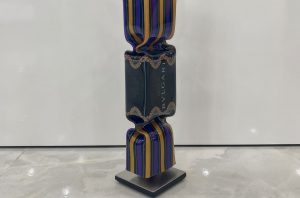
An art museum in the south of France recently made headlines when an art historian discovered that a whopping 60% of its collection is fake.
A museum dedicated to Étienne Terrus, one of the forerunners of the fauvist movement was established in his hometown Elne, near the French border with Spain. When an independent art historian Eric Forcada was hired to rearrange the collection for the reopening of the museum, he quickly discovered that a large part of the collection couldn’t have been made by the French painter. “On one painting, the ink signature was wiped away when I passed my white glove over it”, Eric Forcada stated for the Guardian. Also, the cotton on the canvas didn’t match the one used by Étienne Terrus and certain buildings depicted on the artworks were built long after his death. Subsequently, a panel of experts was summoned to examine the collection and they quickly determined that 82 works out of 140 were forgeries.
The southern ramparts of the town of Elne (1890) by Étienne Terrus. Source
The fact that many museum visitors were tricked into viewing the artworks later deemed a fake, was described as a “catastrophe” by the town’s mayor Yves Barniol, who apologized to everyone who visited the museum in good fate. The incident might have shocked the mayor of the small town in France, but Switzerland’s Fine Art Expert Institute employees would not be that surprised. According to Yann Walther, a director of the Swiss institute specialized in art authentication, over 50% off art pieces that exist on the market today are fake.
Art Forgery Scandals that Shook the World
Art forgery is as old as art itself. The surge in the price of art made forgery a multimillion dollars enterprise. Some forgeries are so obvious that even a pure amateur could see right through them, but others are so good that it takes decades to unveil the truth.
One of the biggest art forgery scandals occurred in the 1930s and 1940s when a little-known Dutch artist Han van Meegeren created and sold several fake Vermeers earning the equivalent of $60 million. His fraud was only discovered after the World War II when he was accused of treason for selling one of his forged Vermeers to the Nazi leader Göring. In a desperate attempt to prove he hadn’t sold the priceless artwork to the Nazis, but only a mere forgery, van Meegeren agreed to paint a new Vermeer in front of the press and court-appointed witnesses thus effectively revoking the accusations of treason and establishing himself as one of the most ingenious forgers of all times.
Van Meegeren might be the most famous forger of them all, but he certainly isn’t the only one. Hungarian painter Elmyr de Hory sold over 100 of Modigliani, Degas, Picasso and Matisse forgeries before the authorities discovered his fraud in the 1970s. In 2004, gallery owner Ely Sakhaiconfessed to buying genuine works of Paul Gauguin, and other Impressionist and modern artists, and then hiring skilled forgers to produce copies which he later sold on Sotheby’s and Christie’s auctions.
The Supper at Emmaus by Han van Meegeren (1936–1937), Museum Boijmans Van Beuningen, Rotterdam. Source
Wolfgang Beltracchi: The Forger of the Century
In recent years, Wolfgang Beltracchi pulled off a hoax that got him the title of “the forger of the century.” Much like van Meegeren who painted “brand new Vermeers”, Beltracchi decided to paint brand new pieces inspired by the works of celebrated painters, rather than forging artworks that already existed. He and his wife Helene managed to sell over 50 forgeries by saying that they were “misplaced pieces” of prominent artists like Max Ernst, Pablo Picasso, and Paul Gauguin, hidden from the Nazis in the 1930s, that had only resurfaced recently. Beltracchi’s works were so spot-on, that they managed to fool some of the finest experts of today including Henrik Hanstein, head of Kunsthaus Lempertz and Werner Spies, the former museum director at Centre Pompidou in Paris. Even famous actor Steve Martin, was tricked into purchasing one of Beltracchi’s forged Campendonks. The pair got away with it for decades but in 2010 experts discovered traces of titanium white on Beltracchi’s 1914 Heinrich Campendonk forgery, a paint that didn’t exist at the time the work was supposedly painted.
Just like famous forgery scandals of the past, the incident at the museum in Elne revived a debate that’s been around for centuries. Why do we, as art enthusiasts care so much for the originals?
An art lover or even a notable art expert can admire a forged art piece for decades, but as soon as the truth about its origin is discovered, the artwork that was considered a masterpiece seconds ago, all of the sudden becomes worthless and despised. Han van Meegeren sold his fakes for tens of millions of dollars, but as soon as the fraud was disclosed their value immediately plummeted, even though not a single line was changed. A forgery by Wolfgang Beltracchi was exhibited at the celebrated Museum of Modern Art (MoMA) in New York, but now it is nothing but evidence in a criminal case against him and his accomplices.
Red Picture with Horses, supposedly by German Expressionist Heinrich Campendonk, forged by Beltracchi; it sold at auction for $3.6m.
Red Picture with Horses, supposedly by German Expressionist Heinrich Campendonk, forged by Beltracchi; it sold at auction for $3.6m Source
Why Authenticity Matters?
Undoubtedly, in the art world, originals hold a special significance. But why is that so?
In an attempt to discover why people care so much for the authenticity of an artwork, researches Newman and Bloom conducted an experiment on 180 participants that were asked to evaluate two paintings by Jim Rilko, they have never seen before: Son of a Covered Bridge and A Covered Bridge. The works are very similar as they both portray the same scenery and this similarity of works was crucial for the experiment.
Half of the participants were told that the paintings were created by two different artists and that their similarity is a pure coincidence. The other half was told that one art piece was painted as an original work while the other piece was made as a copy of the first piece, by an artist inspired by the first painting.
When they were asked to estimate the value of the paintings, the first group attributed a similar value to both paintings while the second group valued the piece they considered to be a copy much lower than the one they considered to be an original. In another experiment by the same researchers, 253 participants valued the sculpture hand-made by the artist much more than the sculpture based on original design but produced with the use of machinery.
The researchers came to a conclusion that our appreciativeness of an artwork doesn’t depend only on the appearance of the final product but also on the originality of the artist’s idea, as well as the level of his personal involvement in the actual creative process. And art forgeries fail on both grounds.
That’s why art forgeries, no matter how close to the original will never be considered anywhere nearly as valuable as the original work of art. It’s almost like we humans believe that artists somehow infuse the essence of themselves into their work simply by touching it. By looking at works by Paul Gauguin or Vermeer we feel connected to them as if somehow we are looking into their minds. And that’s a feeling that forgery, no matter how close to the original, can never evoke.
By Art Acacia




